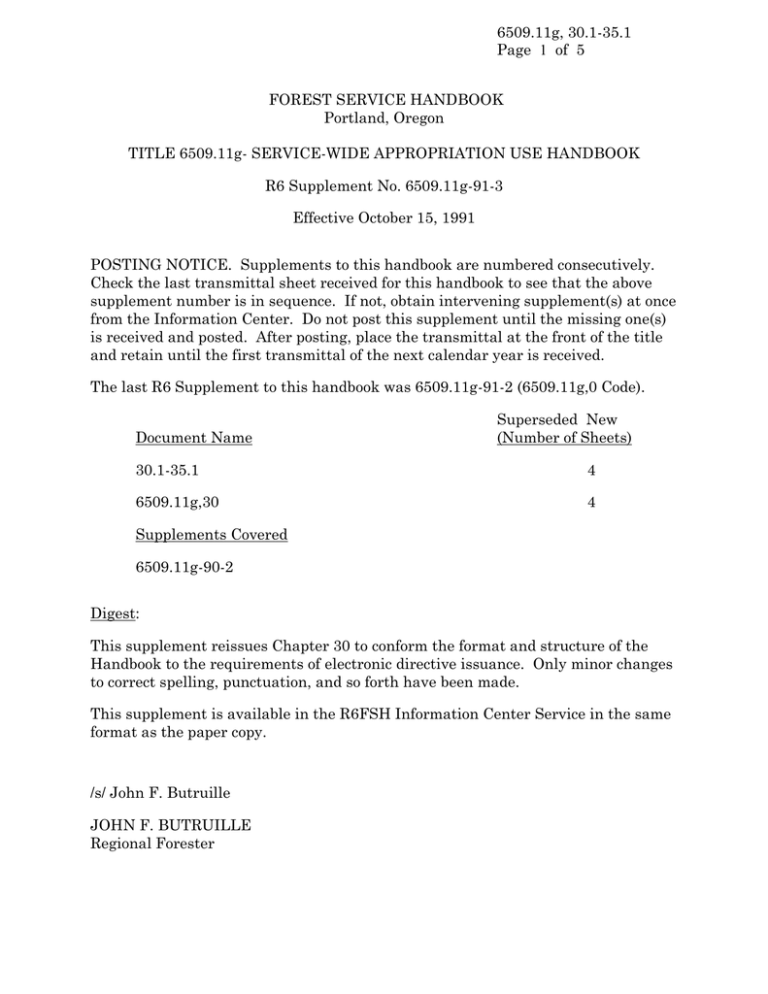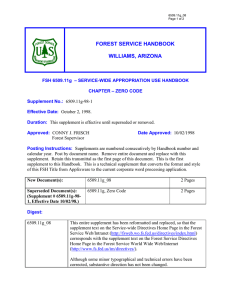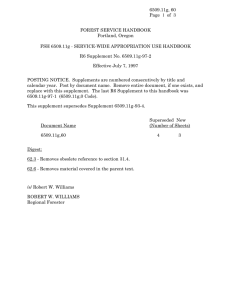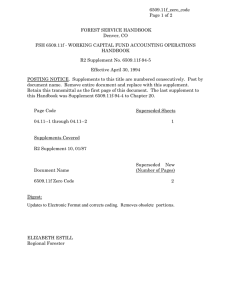6509.11g, 30.1-35.1 Page 1 of 5 FOREST SERVICE HANDBOOK
advertisement

6509.11g, 30.1-35.1 Page 1 of 5 FOREST SERVICE HANDBOOK Portland, Oregon TITLE 6509.11g- SERVICE-WIDE APPROPRIATION USE HANDBOOK R6 Supplement No. 6509.11g-91-3 Effective October 15, 1991 POSTING NOTICE. Supplements to this handbook are numbered consecutively. Check the last transmittal sheet received for this handbook to see that the above supplement number is in sequence. If not, obtain intervening supplement(s) at once from the Information Center. Do not post this supplement until the missing one(s) is received and posted. After posting, place the transmittal at the front of the title and retain until the first transmittal of the next calendar year is received. The last R6 Supplement to this handbook was 6509.11g-91-2 (6509.11g,0 Code). Document Name Superseded New (Number of Sheets) 30.1-35.1 4 6509.11g,30 4 Supplements Covered 6509.11g-90-2 Digest: This supplement reissues Chapter 30 to conform the format and structure of the Handbook to the requirements of electronic directive issuance. Only minor changes to correct spelling, punctuation, and so forth have been made. This supplement is available in the R6FSH Information Center Service in the same format as the paper copy. /s/ John F. Butruille JOHN F. BUTRUILLE Regional Forester R6 SUPPLEMENT 6509.11g-91-3 EFFECTIVE 10/15/91 6509.11g, 30.1-35.1 Page 2 of 5 FSH 6509.11g - SERVICE-WIDE APPROPRIATION USE HANDBOOK R6 SUPPLEMENT 6509.11g-91-3 EFFECTIVE 10/15/91 CHAPTER 30 - NATIONAL FOREST SYSTEM 31 - ANNUAL APPROPRIATION LIMITATIONS. 31.4 - Maintenance of Facilities. Facility maintenance costs can be separated into four categories to help classify the method of charging for maintenance costs. They are: - Single purpose facilities. - Fire, administrative, and general purpose (serves two or more functions) facilities serving National Forest System (NFS) appropriations. - General purpose facilities serving both NFS and non-NFS appropriations. - Quarters. For single purpose facilities, charge the cost of maintenance to the purpose the facility serves. Use a single-line management code which represents that purpose. For fire, administrative, and general purpose facilities serving NFS appropriations only, fund code NFFA with work activity LF2 should be charged. For general purpose facilities serving both NFS and non-NFS appropriations, charge NFFA and work activity LF2 only for the NFS portion of the costs. Charge the non-NFS appropriations and related work activities for their proportionate share of the costs. NFS and non-NFS appropriations pay their respective share of the costs. A multiline management code may be used to record the costs if it is tied to a maintenance work plan which identifies the purpose and estimated maintenance costs of each facility. The following example illustrates charging maintenance cost for a building serving Timber (both regular and SSF), Range, Wildlife, KV, Timber Road Construction, and BD: Fund Code Work Activity Description of Work NFFA LF2 SSSS SSSS CWKV ET114 ET12TM ET24 For NFS share of costs (for example, Timber, Range, and Wildlife). SSF prep share of costs. SSF Admin share of costs. KV Reforestation share of costs. Fund Code Work Activity Description of Work R6 SUPPLEMENT 6509.11g-91-3 EFFECTIVE 10/15/91 CWKV CNTM BDBD ET25 LT123 PF2 6509.11g, 30.1-35.1 Page 3 of 5 KV TSI share of costs. Construction share of costs. BD share of costs. Note: NFS appropriation includes all fund codes that start with NFxx. For quarters maintenance, charge fund code QMQM with work activity LF2. Reference FSH 6509.11k regarding the use of QMQM funds. These funds can be used to operate and/or maintain Forest Service employee quarters only. The QMQM funds are not to be used for other types of facilities or buildings. If there are inadequate QMQM funds to accomplish the necessary quarters maintenance work, this work can be supplemented with charges to regular program funds on a proportional basis to the benefit received. Forest-wide management codes should not be used for facility maintenance. At the District level, the maintenance costs of like kind (equity) facilities (for example, general purpose, and so on) may be charged to one management code. The cost of facilities with different equities must be charged to a separate management code(s). For example, the costs of maintaining several general purpose facilities can be charged to one management code. However, the cost of maintaining residences or a timber purpose facility should be charged to separate management codes that represent the appropriate fund codes and work activity equities for each. 33 - MULTI-YEAR APPROPRIATION LIMITATIONS. 33.1 - Cooperative Law Enforcement. 1. Regular Cooperative law enforcement agreements. The cooperative law enforcement agreements are separated into two different categories of work and are identified by separate Work Activity codes for management purposes. a. Regular cooperative law enforcement agreements are identified by work activity code PL121. This covers the agreements with state and local law enforcement agencies for regular protection activities associated with protecting the public and their property on the National Forests. b. Cannabis agreements are identified by work activity code PL122. This covers agreements with state and local law enforcement agencies for cannibas activities aimed at eliminating the illicit cultivation, manufacture, or distribution of cannabis. 2. Drug Control on the National Forest System. The National Forest System drug control initiative as authorized by Public Law 99-570, Anti-Drug Abuse Act of 1986, Title XV, October 27, as amended, 16 U.S.C. 559b-f, and an agreement with the Attorney General covering drug control on the National Forest System provide authority to take actions necessary in connection with the R6 SUPPLEMENT 6509.11g-91-3 EFFECTIVE 10/15/91 6509.11g, 30.1-35.1 Page 4 of 5 administration and use of the National Forest System to prevent the manufacture, distribution, or dispensing of marijuana and other controlled substances. The act provides for the detection and eradication of cannabis being cultivated within the boundaries of the National Forest System. It also provides for the apprehension and prosecution of persons involved in cultivation operations. Funding for this initiative is provided in Fund Code NFCL, and Work Activity code PL 131 and is to be expended internally for Forest Service operations and is not for reimbursement to State and local law enforcement agencies. Public Law 100-690 amended the Anti-Drug Abuse Act of 1986 to remove the "within the boundary" restriction for carrying out the act. The amended act authorizes the Secretary of Agriculture to conduct investigations and law enforcement actions outside the exterior boundaries of the National Forest System for drug related offenses committed within the National Forest System, or which affect the administration of the National Forest System. These activities include, but are not limited to, salaries, travel, training, contracts, supplies and materials, equipment, including special surveillance and firearms, and other necessary expenses as identified in Regional special drug control plans. Assistance provided by Forest Service personnel to local cooperators being funded by a cooperative law enforcement agreement on activities covered by this act shall be charged to the above fund and work activity code. Assistance provided to local cooperators on other activities (not covered by the Anti-Drug Abuse Act) shall be charged to the benefiting program funds and not NFCL. Prior to the enactment of this act, this work was financed by National Forest System funds. Based on Comptroller General decisions regarding specific versus general appropriations, along with the fact this act authorizes a specific appropriation each fiscal year to carry out the act, and other Forest Service appropriations do not contain specific authority to perform drug control activities, the use of other Forest Service funds to carry out this activity is prohibited. Work outside the scope of the Anti-Drug Abuse Act of 1986, such as work in connection with timber theft, shall continue to be financed by benefiting funds. Law enforcement equipment shall be financed under the benefiting fund principle. Equipment purchased solely as a result of this program may be purchased entirely from these funds following the primary-purpose funding principle in FSH 1909.13, section 41.73, realizing there may be some incidental use by other law enforcement activities normally financed from other Forest Service funds. The principle is that purchase of the equipment is only in response to the Anti-Drug Abuse Act and would not have been purchased otherwise. General equipment that is needed for both the Anti-Drug Abuse Act and other law enforcement activities that serve more than an incidental benefit to one or the other should be financed following the multiple-funding principle in FSH 1909.13, section 41.72. Since these funds are to be appropriated in the National Forest System mainhead appropriation, do not assess general administration expense against them.



